New Insights into Graphite Deposits in Chisone and Germanasca Valleys (Dora-Maira Massif, Western Italian Alps): Scientific Advances and Applied Perspectives
Abstract
1. Introduction
2. Overview of Graphite Types, Genesis, and Mineral Association
3. Geological Background
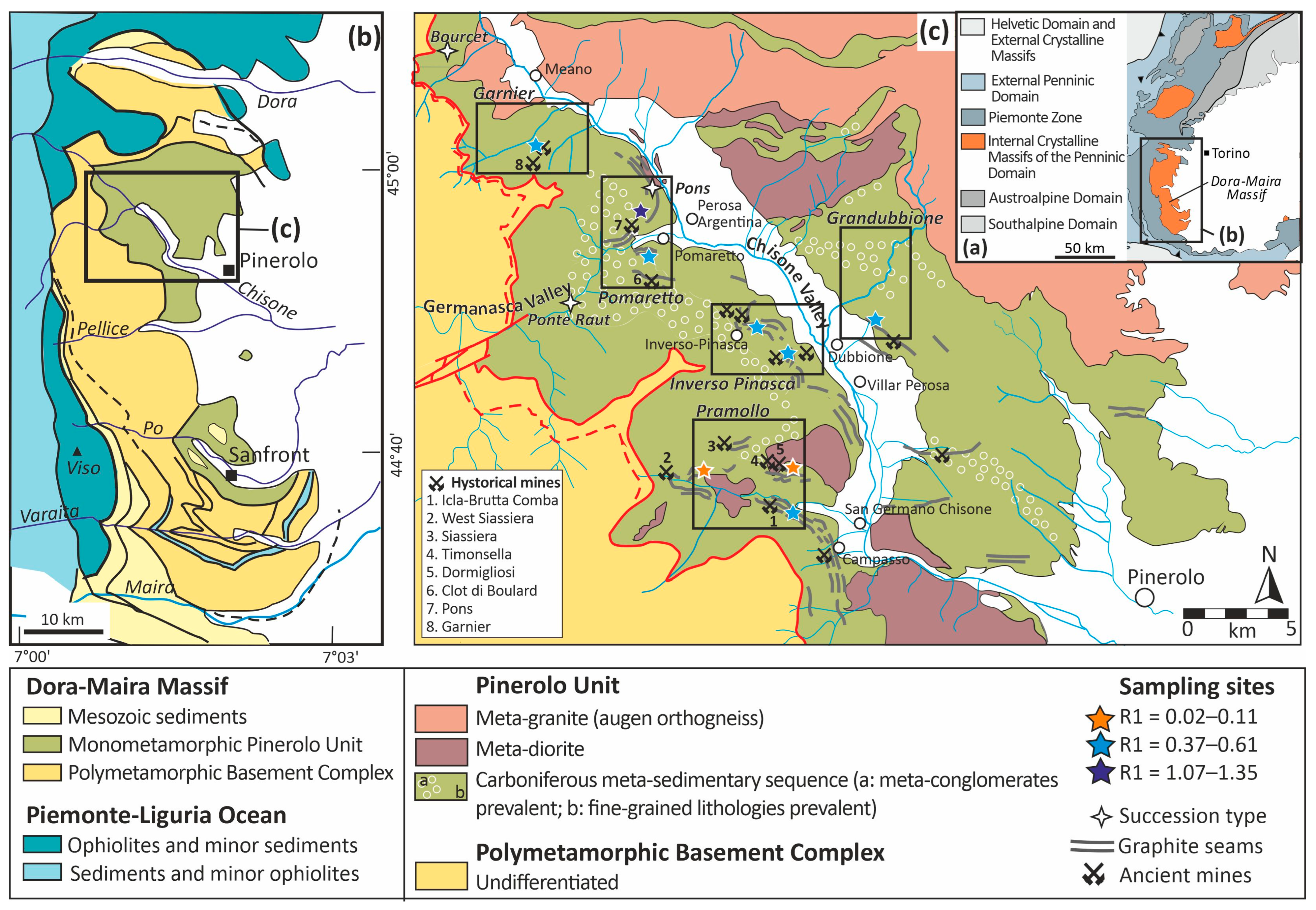
3.1. Lithostratigraphy of the Pinerolo Unit
3.2. Tectono-Metamorphic Evolution of the Pinerolo Unit
3.3. Graphite Mineralization of the Pinerolo Unit
4. Analytical Methods
5. Results
5.1. Field Observations
5.1.1. Bourcet-Type Succession
5.1.2. Pons-Type Succession
5.2. Petrography of the Host Rock
5.2.1. Bourcet-Type Succession
5.2.2. Pons-Type Succession
5.3. Petrography of Graphite Ores
5.3.1. Graphite Mineralization in Bourcet-Type Succession
5.3.2. Graphite Mineralization in Pons-Type Succession
5.4. Degree of Crystallinity
5.5. Mineral Chemistry and Bulk Rock Composition of Graphite Ores
6. Discussion
6.1. Metamorphic Evolution of the Host Lithology
6.2. Genesis of the Graphite Deposits
7. Conclusions
- (a)
- The graphitic mineralization was derived from the deposition of organic matter during the Carboniferous, in a continental sedimentary environment, likely ascribable to a marshland area in an intramontane basin replenished by rivers transporting and depositing its detrital charge during low-energy/low-oxidation periods in agreement with Nosenzo et al., 2024 [74].
- (b)
- The hosting lithologies are characterized by blueschist-facies peak mineral assemblages formed during Alpine subduction, only preserved in the finer-grained lithologies (i.e., meta-argillites and meta-siltstones). The greenschist-facies mineral assemblage, associated with the pervasive schistosity (Sm), is related to Alpine exhumation, and it widely overprints the metamorphic peak paragenesis.
- (c)
- The studies on the morphology, chemistry, and crystallinity of the graphite reveal a difference between the Pramollo (Timonsella Mine) and Pomaretto (Pons Mine) areas. Graphite characterized by high purity and a high crystallinity typical of high-grade metamorphism (Type I) occurs in the Pramollo area. On the contrary, graphite with low purity and a high crystallinity typical of low-grade metamorphism (Type III) is observed in the Pons Mine. This difference likely reveals a difference in their genesis. Interestingly, the samples from the Pramollo area were collected near a Permian metadiorite stock, whose thermo-metamorphic aureole could have induced the graphitization of the organic matter. On the contrary, the graphite collected from several shear zones from the Pons Mine may have been generated via late growth and/or the remobilization of graphite along shear zones active during the exhumation stages of the Alpine orogenesis. Additional detailed analytical works would confirm this hypothesis.
- (d)
- The geological setting, the genetic process, and the main features of the mineralization indicate that the graphite of the Pinerolo Unit belongs to graphite I of Simandl et al., 2015 [24]
- (e)
- Although graphite mineralization is a common exploration target, especially for CRMs (such as V), given the capability of the organic matter to scavenge metallic cations, which can later crystallize as ore minerals during metamorphism, bulk ore geochemical analyses did not reveal economic amounts of CRMs, apart from graphite itself. However, a more extensive geochemical campaign is advisable before excluding the area as an exploration target.
Author Contributions
Funding
Data Availability Statement
Acknowledgments
Conflicts of Interest
Abbreviations
| OM | Optical Microscopy |
| SEM-EDS | Scanning Electron Microscopy–Energy Dispersive Spectroscopy |
| BSE | Backscattering Electron |
| ICP-OES | Inductively Coupled Plasma–Optical Emission Spectrometer |
| ICP-MS | Inductively Coupled Plasma Mass Spectrometry |
| INAA | Instrumental Neutron Activation Analysis |
Appendix A
| Sample ID | Sample Description | Mineralogy | Localities from South to North | Ancient Mines | Latitudine | Longitudine |
|---|---|---|---|---|---|---|
| Bourcet-type succession | ||||||
| DM1862 | Meta-conglomerate with quartz clasts in paragneiss matrix with albite, white mica, and chlorite | Qz, Wm, Chl, Rt, Ttn, Grt, Op | Pramollo-Dormigliosi | Dormigliosi | 44°54′23.44″ N | 07°13′22.34″ E |
| DM1863 | Meta-conglomerate with quartz clasts in paragneiss matrix with albite, white mica, and chlorite | Qz, Wm, Chl | Pramollo-Timonsella | Timonsella | 44°54′23.6″ N | 07°13′31.25″ E |
| DM1864 | Meta-conglomerate with quartz clasts in paragneiss matrix with albite, white mica, and chlorite | Qz, Ab, Wm, Chl, Grt | Pramollo-Miccialetti | 44°54′48.17″ N | 07°12′36.98″ E | |
| DM1865 | Paragneiss with white mica, chlorite, and albite | Qz, Ab, Wm, Chl, Gr | Pramollo-Clotti | 44°54′40.24″ N | 07°12′32.95″ E | |
| DM1866 | Paragneiss with white mica, chlorite, albite, and zoisite | Ab, Qz, Wm, Zoi, Chl, Gr, Bt, Grt, Gln | Pramollo-Tornini | West Siassiera | 44°54′30.37″ N | 07°11′56.02″ E |
| DM1867 | Paragneiss with white mica and graphitic levels | Qz, Wm, Gr, Tt, Ilm, Rt, Fe-ox | Pramollo-Timonsella | Timonsella | 44°54′23.6″ N | 07°13′31.25″ E |
| DM1868 | Quarzitic micaschist with white mica, chlorite, and chlorithoid | Qz, Chl, Wm, Cld, Gr, Bt | Pramollo-Dormigliosi | Dormigliosi | 44°54′20.09″ N | 07°13′17.62″ E |
| DM1869 | Quarzitic micaschist with white mica, chlorite, and chlorithoid | Qz, Wm, Chl, Cld, Gr, Bt | Pramollo-Dormigliosi | Dormigliosi | 44°54′20.09″ N | 07°13′17.62″ E |
| DM1870 | Quarzitic micaschist with white mica, chlorite, chlorithoid, and graphitic levels | Qz, Wm, Chl, Cld, Gr | Pramollo-Miccialetti | 44°54′44.87″ N | 07°12′33.45″ E | |
| DM1871 | Micaschist with white mica and chlorite | Wm. Qz, Chl, Ab, Gr | Pramollo-Cagliera | 44°54′59.47″ N | 07°14′03.51″ E | |
| DM1872 | Micaschist with white mica and chlorite, porphyroblasts of garnet, and pseudomorphosis on original lawsonite | W, Qz, Chl, Ab, Grt, Ep, Gr, Rt, Cld, ex-Lws | Pramollo-Tornini | West Siassiera | 44°54′25.21″ N | 07°11′58.16″ E |
| DM1873 | Graphite mineralization and quartz + chlorite vein | Gr, Wm, Ab, Chl, Qz | Pramollo-Tornini | West Siassiera | 44°54′30.37″ N | 07°11′56.02″ E |
| DM1874 | Graphite mineralization | Gr, Wm, Qz, Chl | Pramollo-Tornini | West Siassiera | 44°54′30.37″ N | 07°11′56.02″ E |
| DM1875 | Graphite mineralization and quartz + chlorite vein | Gr, Qz, Wm, Chl, Bt | Pramollo-Dormigliosi | Dormigliosi | 44°54′20.09″ N | 07°13′17.62″ E |
| DM1877 | Meta-conglomerate with quartz clasts in paragneiss matrix with albite, white mica, biotite, and garnet | Ab, Qz, Bt, Wm, Grt, Chl, Gr | Dubbione-Tagliaretto | 44°57′23.6″ N | 07°15′19.83″ E | |
| DM1878 | Paragneiss with albite, biotite, white mica, and garnet | Ab, Qz, Bt, Wm, Grt, Chl, Gr | Dubbione-Tagliaretto | 44°57′27.27″ N | 07°15′21.07″ E | |
| DM1879 | Gneissic micaschist with albite, white mica biotite and garnet | Qz, Ab, Wm, Grt, Chl, Gr, Bt | Dubbione-Tagliaretto | 44°57′21.82″ N | 07°15′27.07″ E | |
| DM1894 | Graphitic micaschist with white mica, garnet, and chlorite | Gr, Wm, Qz, Chl, Grt, Ab | Garnier W | Garnier | 44°58′45.24″ N | 07°08′45.57″ E |
| DM1895 | Micaschist with white mica, chlorite, and granet | Qz, Wm, Gr, Grt, Chl, Ab | Garnier W | Garnier | 44°58′45.24″ N | 07°08′45.57″ E |
| DM1896 | Micaschist with white mica, biotite, garnet, and albite | Qz, Wm, Ab, Grt, Chl, Bt | Garnier E | Garnier | 44°58′44.93″ N | 07°08′58.36″ E |
| Pons -type succession | ||||||
| DM1880 | Graphitic micaschist with white mica, chlorite, and garnet porphyroblasts | Wm, Qz, Chl, Ab, Gr, Grt, Bt | Dubbione-Anselm | 44°56′30.46″ N | 07°14′21.98″ E | |
| DM1881 | Graphitic micaschist with white mica, albite, and garnet porphyroblasts | Wm, Qz, Chl, Ab, Gr, Grt, Bt | Dubbione-Giborgo | 44°56′44.4″ N | 07°14′57.46″ E | |
| DM1882 | Graphitic micaschist with white mica, albite, biotite, and garnet porphyroblasts | Wm, Ab, Qz, Grt, Chl, Bt, Gr | Dubbione-Giustetti | 44°56′35″ N | 07°14′24.97″ E | |
| DM1883 | Graphitic micaschist with white mica and chloritoid | Wm, Qz, Cld, Chl, Ab, Gr, Ilm | Dubbione-Giborgo | 44°56′41.27″ N | 07°14′56.96″ E | |
| DM1884 | Graphite mineralization with quartz + chlorite vein | Gr, Wm, Qz, Chl, Ab, Bt | Dubbione-Tagliaretto | 44°57′27.27″ N | 07°15′21.07″ E | |
| DM1885 | Graphitic micaschist with albite, chlorite, and garnet | Wm, Ab, Qz, Chl, Gr, Grt | I. Pinasca- Palazzotto | 44°56′05.56″ N | 07°13′01.57″ E | |
| DM1886 | Graphite mineralization with quartz + chlorite vein | Gr, Wm, Chl, Qz | I. Pinasca-Vivian | 44°55′58.13″ N | 07°13′23.63″ E | |
| DM1887 | Micro augen-gneisswith chlorite, white mica, and garnet with albite ocelli | Ab, Qz, Chl, Wm, Grt, Gr | Pomaretto-Pons | Pons | 44°57′43.69″ N | 07°10′54.19″ E |
| DM1888 | Graphitic micascist with white mica and chlorite | Wm, Qz, Chl, Gr, Ab, Bt, Ilm | Pomaretto-Pons | Pons | 44°57′50.05″ N | 07°10′28.43″ E |
| DM1889 | Graphitic micascist with albite, white mica, and chlorite | Ab, Wm, Chl, Qz, Gr, Ep, Grt | Pomaretto- Pons | Pons | 44°58′09.25″ N | 07°10′29.97″ E |
| DM1890 | Augen Paragneiss with white mica, chlorite, garnet, and albite ocelli | Ab, Wm, Chl, Qz, Gr, Grt, Rt, Ilm | Pomaretto-Clot di Boulard | Clot di Boulard | 44°56′58.32″ N | 07°10′46.83″ E |
| DM1891 | Graphite mineralization + garnet, white mica, and chlorite | Gr, Grt, Wm, Chl, Ab, Op, Qz | Pomaretto- Clot di Boulard | Clot di Boulard | 44°56′58.32″ N | 07°10′46.83″ E |
| DM1892 | Graphite mineralization + ilmenite and pyrite | Gr, Qz, Chl, Wm, Fe-ox, Py, Ilm | Pomaretto-Clot di Boulard | Clot di Boulard | 44°56′58.32″ N | 07°10′46.83″ E |
| DM1893 | Graphite mineralization with white mica veins + biotitized chlorite | Gr, Ilm, Wm, Ab, Chl, Bt | Pomaretto- Pons | Pons | 44°57′43.69″ N | 07°10′54.19″ E |
| Other | ||||||
| DM1876 | Meta-quartzdiorite | Zoi, Ab, Qz, Act, Bt, Chl, Grt, Rt, Ilm, Ttn | Pramollo-Bric dei Pini | 44°54′39.21″ N | 07°13′23.27″ E | |
Appendix B
| Pramollo (Timonsella) | Pomaretto (Pons) | |
|---|---|---|
| % | ||
| SiO2 | 75.31 | 57.67 |
| Al2O3 | 15.25 | 21.22 |
| Fe2O3 | 3.17 | 9.94 |
| MnO | 0.007 | 0.058 |
| MgO | 0.64 | 2.84 |
| CaO | 0.05 | 0.21 |
| Na2O | 0.26 | 0.93 |
| K2O | 3.98 | 5.4 |
| TiO2 | 1.062 | 1.072 |
| P2O5 | 0.06 | 0.13 |
| LOI | 0.21 | 0.28 |
| Total | 100 | 99.74 |
| C-graph | 14 | 6.14 |
| S | 0.003 | 0.22 |
| ppm | ||
| Ni | 12 | 51 |
| Cu | 47 | 48 |
| Zn | 60 | 106 |
| Pb | 299 | 9 |
| Be | 2 | 3 |
| V | 111 | 168 |
| Co | 2 | 10 |
| Ga | 23 | 31 |
| Ge | 2 | 2 |
| Rb | 163 | 234 |
| Sr | 34 | 45 |
| Y | 16 | 37 |
| Zr | 220 | 233 |
| Nb | 18 | 16 |
| Mo | 15 | < 2 |
| Ag | 1.6 | < 0.5 |
| Sn | 2 | 6 |
| Cs | 4.3 | 9.7 |
| Ba | 797 | 1124 |
| Hf | 5.3 | 5.6 |
| Ta | 1.3 | 1 |
| W | 13 | 6 |
| Tl | 0.7 | 0.9 |
| Bi | 13.1 | 0.7 |
| Th | 14.1 | 15 |
| U | 2.8 | 4.2 |
| Au | 31 | 7 |
| As | 371 | 11 |
| Cr | 88 | 132 |
| Sb | 6.6 | 39.2 |
| Sc | 10.3 | 19.3 |
| ppm | ||
| La | 8.8 | 43.9 |
| Ce | 14.2 | 85.3 |
| Pr | 2.04 | 9.12 |
| Nd | 8.2 | 38.5 |
| Sm | 1.8 | 7.7 |
| Eu | 0.28 | 1.57 |
| Gd | 2.1 | 6.8 |
| Tb | 0.3 | 1.1 |
| Dy | 1.9 | 6 |
| Ho | 0.4 | 1.2 |
| Er | 1.3 | 3.2 |
| Tm | 0.19 | 0.48 |
| Yb | 1.5 | 3.3 |
| Lu | 0.25 | 0.51 |
| ΣREEs | 43.26 | 208.68 |
References
- Wissler, M. Graphite and carbon powders for electrochemical applications. J. Power Sources 2006, 156, 142–150. [Google Scholar] [CrossRef]
- Taylor, H.A. Graphite. In Industrial Minerals and Rocks; Kogel, J.E., Trivedi, N.C., Barker, J.M., Krukowski, W.T., Eds.; Society for Mining, Metallurgy, and Exploration: Littleton, CO, USA, 2006; pp. 507–518. [Google Scholar]
- Moore, S.; O’Driscoll, M.; Russell, R. Natural Graphite Report 2012; Industrial Minerals: London, UK, 2012. [Google Scholar]
- Olson, D.W. Graphite: U.S. Geological Survey, 2014 Minerals Yearbook. 2014. Available online: https://d9-wret.s3.us-west-2.amazonaws.com/assets/palladium/production/mineral-pubs/graphite/myb1-2014-graph.pdf (accessed on 22 April 2025).
- Olson, D.W. Graphite (Natural): U.S. Geological Survey, Mineral Commodity Summaries. January 2017. Available online: https://apps.usgs.gov/minerals-information-archives/mcs/mcs2017.pdf (accessed on 24 March 2025).
- Simland, G.J.; Neetz, M. Symposium on Critical and Strategic Material Proceedings. 13–14 November 2015, Victoria, British Columbia. Available online: https://cmscontent.nrs.gov.bc.ca/geoscience/publicationcatalogue/Paper/BCGS_P2015-03.pdf (accessed on 22 April 2025).
- Scherba, C.; Montreuil, J.-F.; Barrie, C.T. Chapter 15: Geology and Economics of the Giant Molo Graphite Deposit, Southern Madagascar. In Metals, Minerals, and Society; Society of Economic Geologists: Littleton, CO, USA, 2018; Volume 21, pp. 347–363. [Google Scholar] [CrossRef]
- Wu, Z.-S.; Ren, W.; Gao, L.; Liu, B.; Jiang, C.; Cheng, H.-M. Synthesis of high-quality graphene with a pre-determined number of layers. Carbon 2009, 47, 493–499. [Google Scholar] [CrossRef]
- Badenhorst, H. Microstructure of natural graphite flakes revealed by oxidation: Limitations of XRD and Raman techniques for crystallinity estimates. Carbon 2014, 66, 674–690. [Google Scholar] [CrossRef]
- Badenhorst, H. A review of the application of carbon materials in solar thermal energy storage. Sol. Energy 2019, 192, 35–68. [Google Scholar] [CrossRef]
- European Commission. List of Critical Raw Materials for the EU. 2017. Available online: https://eur-lex.europa.eu/legal-content/EN/TXT/?uri=CELEX:52017DC0490 (accessed on 24 March 2025).
- European Commission. Critical Raw Materials Resilience: Charting a Path Towards Greater Security and Sustainability. 2020. Available online: https://eur-lex.europa.eu/legal-content/EN/TXT/?uri=CELEX:52020DC0474 (accessed on 24 March 2025).
- European Commission. Critical Materials for Strategic Technologies and Sectors in the EU—A Foresight Study. 2020. Available online: https://ec.europa.eu/docsroom/documents/42882 (accessed on 24 March 2025).
- European Commission. Study on the Critical Raw Materials for the EU 2023. 2023. Available online: https://op.europa.eu/en/publication-detail/-/publication/57318397-fdd4-11ed-a05c-01aa75ed71a1 (accessed on 24 March 2025).
- Robinson, G.R., Jr.; Hammarstrom, J.M.; Olson, D.W. Chapter J: Graphite. In Critical Mineral Resources of the United States—Economic and Environmental Geology and Prospects for Future Supply; Professional Paper 1802; Schulz, K.J., DeYoung, J.H., Jr., Seal, R.R., II, Bradley, D., Eds.; United States Geological Survey: Reston, VA, USA, 2017; pp. J1–J24. [Google Scholar]
- United Nations. Transforming Our World: The 2030 Agenda for Sustainable Development, General Assembly, Session 70/01 (A/RES/70/1). 21 October 2015. Available online: https://sdgs.un.org/2030agenda (accessed on 24 March 2025).
- Pierson, H.O. Handbook of Carbon, Graphite, Diamonds and Fullerenes: Processing, Properties and Applications; William Andrew Publishing: Amsterdam, The Netherland, 2012. [Google Scholar]
- Zhao, H.; Ren, J.; He, X.; Li, J.; Jiang, C.; Wan, C. Purification and carbon-film-coating of natural graphite as anode materials for Li-ion batteries. Electrochim. Acta 2007, 52, 6006–6011. [Google Scholar] [CrossRef]
- Statista. Available online: https://www.statista.com/statistics/452281/graphite-demand-worldwide-prediction-by-application/#statisticContainer (accessed on 24 March 2025).
- U.S. Geological Survey. Mineral Commodity Summaries. National Minerals Information Center. 2024. Available online: https://pubs.usgs.gov/publication/mcs2025 (accessed on 24 March 2025).
- European Union. Regulation (EU) 2024/1252 of the European Parliament and of the Council of 11 April 2024 Establishing a Framework for Ensuring a Secure and Sustainable Supply of Critical Raw Materials and Amending Regulations (EU) No 168/2013, (EU) 2018/858, (EU) 2018/1724 and (EU) 2019/1020. 2024. Available online: https://eur-lex.europa.eu/legal-content/EN/TXT/?uri=OJ:L_202401252 (accessed on 24 March 2025).
- Decreto Legge 25 giugno 2024, n. 84 Disposizioni Urgenti Sulle Materie Prime Critiche di Interesse Strategico. Available online: https://temi.camera.it/leg19/provvedimento/d-l-84-2024-disposizioni-urgenti-sulle-materie-prime-critiche-di-interesse-strategico.html (accessed on 24 March 2025).
- Pasteris, J.D. Causes of the Uniformly High Crystallinity of Graphite in Large Epigenetic Deposits. J. Metam. Geol. 1999, 17, 779–787. [Google Scholar] [CrossRef]
- Simandl, G.J.; Paradis, S.; Akam, C. Graphite Deposit Types, Their Origin, and Economic Significance. In Symposium on Strategic and Critical Materials Proceedings, 13–14 November 2015, Victoria, British Columbia, British Columbia Ministry of Energy and Mines, British Columbia Geological Survey Paper 2015; Simandl, G.J., Neetz, M., Eds.; 2015; Volume 3, pp. 163–171. Available online: https://cmscontent.nrs.gov.bc.ca/geoscience/publicationcatalogue/Paper/BCGS_P2015-03-19_Simandl.pdf (accessed on 24 March 2025).
- Ridoni, E. Il Talco e la Grafite delle Alpi Cozie. L’industria Mineraria d’Italia e d’Oltremare 1938, n.4-6, Stabilimento Grafico F. Lega, Faenza. Available online: https://www.pralymania.com/Ridoni/TalcoGrafiteAlpiCozie.pdf (accessed on 25 March 2025).
- Kwiecińska, B.; Petersen, H.I. Graphite, semi-graphite, natural coke, and natural char classification—ICCP system. Int. J. Coal Geol. 2004, 57, 99–116. [Google Scholar] [CrossRef]
- Beyssac, O.; Rumble, D. Graphitic Carbon: A Ubiquitous, Diverse, and Useful Geomaterial. Elements 2014, 10, 415–420. [Google Scholar] [CrossRef]
- Luque, F.J.; Huizenga, J.M.; Crespo-Feo, E.; Wanda, H.; Ortega, L.; Barrenechea, J.F. Vein graphite deposits: Geological settings, origin, and economic significance. Miner. Deposita 2014, 49, 261–277. [Google Scholar] [CrossRef]
- Simandl, G.J. Gîtes de Graphite de la Région de la Gatineau, Québec. Ph.D. Thesis, Université de Montréal, Montreal, QC, Canada, 1992; p. 383, Unpublished. [Google Scholar]
- Luque, F.J.; Pasteris, J.D.; Wopenka, B.; Rodas, M.; Barrenechea, J.F. Natural fluid deposited graphite: Mineralogical characteristics and mechanisms of formation. Am. J. Sci. 1998, 298, 471–498. [Google Scholar] [CrossRef]
- Rodas, M.; Luque, F.J.; Barrenechea, J.F.; Fernández-Caliani, J.C.; Miras, A.; Fernández-Rodríguez, C. Graphite occurrences in the low-pressure/high-temperature metamorphic belt of the Sierra de Aracena (southern Iberian Massif). Mineral. Mag. 2000, 64, 801–814. [Google Scholar] [CrossRef]
- Taner, M.F.; Drever, C.; Yakymchuk, C.; Longstaffe, F.J. Origin of Graphite in the Southwestern Grenville Province. Can. Miner. 2017, 55, 1041–1055. [Google Scholar] [CrossRef]
- Chelgani, S.C.; Rudolph, M.; Kratzsch, R.; Sandmann, D.; Gutzmer, J. A Review of Graphite Beneficiation Techniques. Miner. Process. Extr. Metall. Rev. 2016, 37, 58–68. [Google Scholar] [CrossRef]
- Kaya, Ö.; Canbazoğlu, M. Chemical demineralization of three different graphite ores from Turkey. Min. Metall. Explor. 2009, 26, 158–162. [Google Scholar] [CrossRef]
- Vasumathi, N.; Vijaya Kumar, T.V.; Ratchambigai, S.; Subba Rao, S.; Bhaskar Raju, G. Flotation studies on low grade graphite ore from eastern India. Int. J. Min. Sci. Technol. 2015, 25, 415–420. [Google Scholar] [CrossRef]
- Vasumathi, N.; Sarjekar, A.; Chandrayan, H.; Chennakesavulu, K.; Reddy, G.R.; Kumar, T.V.V.; El-Gendy, N.S.; Gopalkrishna, S.J. A Mini Review on Flotation Techniques and Reagents Used in Graphite Beneficiation. Int. J. Chem. Eng. 2023, 2023, 1007689. [Google Scholar] [CrossRef]
- Jara, A.D.; Woldetinsae, G.; Betemariam, A.; Kim, J.Y. Mineralogical and petrographic analysis on the flake graphite ore from Saba Boru area in Ethiopia. Int. J. Min. Sci. Technol. 2020, 30, 715–721. [Google Scholar] [CrossRef]
- Di Cecco, V.E.; Tait, K.T.; Spooner, E.T.C.; Scherba, C. The Vanadium-bearing oxide minerals of the Green Giant Vanadium-Graphite deposit, Southwest Madagascar. Can. Miner. 2018, 56, 247–257. [Google Scholar] [CrossRef]
- Syrah Resources Ltd. Balama Graphite Project. 2014. Available online: https://www.mining-technology.com/projects/balama-graphite-project/ (accessed on 24 March 2025).
- Koneva, A.A. Cr-V oxides in metamorphic rocks, Lake Baikal, Russia. Neues Jahrbuch Mineralogie–Monatshefte Jg. 2002, 12, 541–550. [Google Scholar] [CrossRef]
- Couëslan, C.G. Affinity and Petrogenesis of the Huzyk Creek Metal-Enriched Graphite Deposit: A Metamorphosed Metalliferous Black Shale in the Trans-Hudson Orogen Of Manitoba, Canada. Can. Miner. 2022, 60, 853–880. [Google Scholar] [CrossRef]
- Medenbach, O.; Schmetzer, K. Schreyerit (V2Ti3O9), ein neues Vanadium-Mineral aus Kenya. Naturwissenschaften 1976, 63, 293–294. [Google Scholar] [CrossRef]
- Jeong, G.Y. Mineralogy and geochemistry of metalliferous black slates in the okcheon metamorphic belt, Korea: A metamorphic analogue of black shales in the South China block. Miner. Deposita 2006, 41, 469–481. [Google Scholar] [CrossRef]
- Rose, E.R. Geology of Vanadium and Vanadiferous Occurrences of Canada. In Economic Geology Report No. 27; Geological Survey of Canada: Ottawa, ON, Canada, 1973. [Google Scholar]
- Breit, G.N.; Wanty, R.B. Vanadium accumulation in carbonaceous rocks: A review of geochemical controls during deposition and diagenesis. Chem. Geol. 1991, 91, 83–97. [Google Scholar] [CrossRef]
- Parnell, J. Snowball Earth to Global Warming: Coupled vanadium-carbonaceous deposits in the Cryogenian-Cambrian. Ore Geol. Rev. 2022, 145, 104876. [Google Scholar] [CrossRef]
- Schmid, S.M.; Fügenschuh, B.; Kissling, E.; Schuster, R. Tectonic map and overall architecture of the Alpine orogen. Eclogae Geol. Hel. 2004, 97, 93–117. [Google Scholar] [CrossRef]
- Ballèvre, M.; Camonin, A.; Manzotti, P.; Poujol, M. A step towards unraveling the paleogeographic attribution of pre-Mesozoic basement complexes in the Western Alps based on U–Pb geochronology of Permian magmatism. Swiss J. Geosci. 2020, 113, 12. [Google Scholar] [CrossRef]
- Michard, A.; Schmid, S.M.; Lahfid, A.; Ballèvre, M.; Manzotti, P.; Chopin, C.; Iaccarino, S.; Dana, D. The Maira-Sampeyre and Val Grana allochthons (south Western Alps): Review and new data on the tectonometamorphic evolution of the Briançonnais distal Margin. Swiss J. Geosci. 2022, 115, 19. [Google Scholar] [CrossRef]
- Balestro, G.; Festa, A.; Cadoppi, P.; Groppo, C.; Roà, M. Pre-orogenic tectonostratigraphic evolution of the European distal margin-Alpine Tethys transition zone in high-pressure units of the southwestern. Alps. Geosci. 2022, 12, 358. [Google Scholar] [CrossRef]
- Balestro, G.; Cadoppi, P.; Piccardo, G.B.; Polino, R.; Spagnolo, G.; Tallone, S.; Fioraso, G.; Lucchesi, S.; Forno, M.G. Note Illustrative della Carta Geologica d’Italia Alla Scala 1:50000. Foglio 155 “Torino Ovest”; Servizio Geologico d’Italia: Roma, Italy, 2009. [Google Scholar]
- Vialon, P. Etude Géologique du Massif Cristallin Dora-Maira, Alpes Cottiennes Internes, Italie. Ph.D. Thesis, Université de Grenoble, Grenoble, France, 1966. [Google Scholar]
- Chopin, C.; Henry, C.; Michard, A. Geology and petrology of the coesite-bearing terrain, Dora Maira Massif, Western Alps. Eur. J. Miner. 1991, 3, 263–292. [Google Scholar] [CrossRef]
- Michard, A.; Henry, C.; Chopin, C. Structures in UHPM rocks: A case study from the Alps. In Ultrahigh Pressure Metamorphism; Coleman, R.G., Wang, X., Eds.; Cambridge University Press: Cambridge, UK, 1995; pp. 206–243. [Google Scholar]
- Compagnoni, R.; Rolfo, F. UHPM Units in the Western Alps. EMU Notes Mineral. 2003, 5, 13–49. [Google Scholar] [CrossRef]
- Compagnoni, R.; Rolfo, F.; Groppo, C.; Hirajima, T.; Turello, R. Geological map of the ultra-high pressure Brossasco-Isasca unit (Western Alps, Italy). J. Maps. 2012, 8, 465–472. [Google Scholar] [CrossRef]
- Castelli, D.; Rolfo, F.; Groppo, C.; Compagnoni, R. Impure marbles from the UHP Brossasco-Isasca Unit (Dora-Maira massif, Western Alps): Evidence for alpine equilibration in the diamond stability field and evaluation of the X (CO2) fluid evolution. J. Metam. Geol. 2007, 25, 587–603. [Google Scholar] [CrossRef]
- Groppo, C.; Castelli, D.; Rolfo, F.H.T. Pre-alpine relics in a spinel-bearing dolomite marble from the UHP Brossasco-Isasca Unit (Dora-Maira massif, Western Alps). Period Miner. 2007, 76, 155–168. [Google Scholar] [CrossRef]
- Nosenzo, F.; Manzotti, P.; Poujol, M.; Ballèvre, M.; Langlade, J. A window into an older orogenic cycle: P-T conditions and timing of the pre-Alpine history of the Dora-Maira Massif (Western Alps). J. Metam. Geol. 2022, 40, 789–821. [Google Scholar] [CrossRef]
- Chopin, C. Coesite and pure pyrope in high-grade blueschist of the Western Alps: A first record and some consequences. Contrib. Mineral. Petrol. 1984, 86, 107–118. [Google Scholar] [CrossRef]
- Ferrando, S.; Groppo, C.; Frezzotti, M.L.; Castelli, D.; Proyer, A. Dissolving dolomite in a stable UHP mineral assemblage: Evidence from Cal-Dol marbles of the Dora-Maira massif (Italian Western Alps). Am. Min. 2017, 102, 42–60. [Google Scholar] [CrossRef]
- Groppo, C.; Ferrando, S.; Gilio, M.; Botta, S.; Nosenzo, F.; Balestro, G.; Festa, A.; Rolfo, F. What’s in the sandwich? New P–T constraints for the (U)HP nappe stack of southern Dora-Maira massif (Western Alps). Eur. J. Miner. 2019, 31, 665–683. [Google Scholar] [CrossRef]
- Manzotti, P.; Schiavi, F.; Nosenzo, F.; Pitra, P.; Ballèvre, M. A journey towards the forbidden zone: A new cold UHP unit in the Dora-Maira Massif (Western Alps). Contrib. Miner. Pet. 2022, 177, 59. [Google Scholar] [CrossRef]
- Manzotti, P.; Ballèvre, M.; Poujol, M. Detrital zircon geochronology in the Dora-Maira and zone houillère: A record of sediment travel paths in the Carboniferous. Terra Nova 2016, 28, 279–288. [Google Scholar] [CrossRef]
- Avigad, D.; Chopin, C.; Le Bayon, R. Thrusting and extension in the southern Dora-Maira ultra-high pressure Massif (Western Alps): View from below the coesite-bearing Unit. J. Geol. 2003, 111, 57–70. [Google Scholar] [CrossRef]
- Bonnet, G.; Chopin, C.; Locatelli, M.; Kyander-Clark, A.; Hacker, B.R. Protracted subduction of the European hyperextended margin revealed by rutile U-Pb geochronology across the Dora-Maira massif (W. Alps). Tectonics 2022, 41, e2021TC007170. [Google Scholar] [CrossRef]
- Nerone, S.; Petroccia, A.; Caso, F.; Dana, D.; Maffeis, A. Assessing the importance of H2O content in the tectonometamorphic evolution of shear zones: A case study from the Dora-Maira Massif (Western Alps). J. Metam. Geol. 2023, 42, 171–196. [Google Scholar] [CrossRef]
- Cadoppi, P. Geologia del Basamento Cristallino nel Settore Settentrionale del Massiccio Dora-Maira (Alpi Occidentali). Ph.D. Thesis, University of Torino, Torino, Italy, 1990. [Google Scholar]
- Borghi, A.; Cadoppi, P.; Dino, G.A. Heritage stone 2. The Dora-Maira Unit (Italian Cottian Alps): A reservoir of ornamental stones since Roman times. Geosci. Can. 2016, 43, 13–30. [Google Scholar] [CrossRef]
- Bussy, F.; Cadoppi, P. U-Pb zircon dating of granitoids from the Dora-Maira massif (Western Italian Alps). Schweiz. Mineral. Petrogr. Mitt. 1996, 76, 217–233. [Google Scholar]
- Cadoppi, P.; Cammanni, G.; Balestro, G.; Perrone, G. Geology of the Fontane talc mineralization (Germanasca valley, Italian Western Alps). J. Maps. 2016, 12, 1170–1177. [Google Scholar] [CrossRef]
- Groppo, C.; Ferrando, S.; Tursi, F.; Rolfo, F. New UHP-HP tectono-metamorphic architecture for the southern Dora-Maira Massif nappe stack (Western Alps) based on petrological and microstructural evidence. J. Metam. Geol. 2025, 43, 359–383. [Google Scholar] [CrossRef]
- Cadoppi, P.; Castelletto, M.; Sacchi, R.; Baggio, P.; Carraro, F.; Giraud, V. Note Illustrative Della Carta Geologica d’Italia Alla Scala 1:50000–Foglio 154 “Susa”; Servizio Geologico d’Italia: Rome, Italy, 2002; 123p. [Google Scholar]
- Nosenzo, F.; Manzotti, P.; Krona, M.; Ballévre, M.; Poujol, M. Tectonic architecture of the northern Dora-Maira Massif (Western Alps, Italy): Field and geochronological data. Swiss J. Geosci. 2024, 117, 6. [Google Scholar] [CrossRef]
- Borghi, A.; Cadoppi, P.; Porro, A.; Sacchi, R. Metamorphism in the North part of the Dora-Maira Massif (Cottian Alps). Boll. Mus. Reg. Sci. Nat. Torino. 1985, 3, 369–380. [Google Scholar]
- Bousquet, R.; Oberhänsli, R.; Schmid, S.M.; Berger, A.; Wiederkehr, M.; Robert, C.; Möller, A.; Rosenberg, C.; Zeilinger, G.; Molli, G. Metamorphic framework of the Alps. In Commission for the Geological Map of the World; Subcommission for Magmatic and Metamorphic Maps; IUGS and IUGG: Paris, France, 2012; Available online: http://www.ccgm.org (accessed on 24 March 2025).
- Westin, W. Thermal Structure of a Paleo-Subduction Zone (Dora-Maira Massif, Western Alps). Master’s Thesis, Department of Geological Sciences, Stockholm University, Stockholm, Sweden, 2022. [Google Scholar]
- Cadoppi, P.; Tallone, S.; Scambelluri, M.; Federico, L.; Capponi, G.; Crispini, L.; Piccardo, G.B.; Rampone, E.; Romarone, A. Esumazione di Crosta Continentale e di Litosfera Oceanica Subdotte; 81° Riunione della Società Geologica Italiana: Torino, Italy, 2002; 92p. [Google Scholar]
- Mattirolo, E.; Novarese, V.; Franchi, S.; Stella, A. Carta Geologica d’Italia alla scala 1:100.000, Foglio 67 Pinerolo; Geological Survey of Italy: Roma, Italy, 1913. [Google Scholar]
- Ridoni, E. La grafite, L’industria Chimica, Mineraria e Metallurgica, 1917, 22-23-24, Tipografia Olivero & c. Available online: https://www.pralymania.com/Ridoni/Ridoni%20Grafite%201917.pdf (accessed on 24 March 2025).
- Castaldo, G.; Stampanoni, G. Memoria illustrativa della carta mineraria d’Italia. Scala 1:1.000.000. In Memorie per Servire alla Descrizione della Carta Geologica d’Italia; Ministero dell’industria del Commercio e dell’artigianato Servizio Geologico d’Italia: Roma, Italy, 1975; Volume XIV. [Google Scholar]
- Pasteris, J.D.; Wopenka, B. Raman spectra of graphite as indicators of degree of metamorphism. Can Miner. 1991, 29, 1–9. [Google Scholar]
- Beyssac, O.; Goffe, B.; Chopin, C.; Rouzaud, J.N. Raman spectra of carbonaceous material in metasediments: A new geothermometer. J. Metam. Geol. 2002, 20, 859–871. [Google Scholar] [CrossRef]
- Beyssac, O.; Brunet, F.; Petitet, J.P.; Goffè, B.; Rouzaud, J.N. Experimental study of the microtextural and structural transformations of carbonaceous materials under pressure and temperature. Eur. J. Miner. 2003, 15, 937–951. [Google Scholar] [CrossRef]
- Whitney, D.L.; Evans, B.W. Abbreviations for Names of Rock-Forming Minerals. Am. Miner. 2010, 95, 185–187. [Google Scholar] [CrossRef]
- Rahl, J.M.; Anderson, K.M.; Brandon, M.T.; Fassoulas, C. Raman spectroscopic carbonaceous material thermometry of low-grade metamorphic rocks: Calibration and application to tectonic exhumation in Crete, Greece. EPS Lett. 2005, 240, 339–354. [Google Scholar] [CrossRef]
- Lahfid, A.; Beyssac, O.; Deville, E.; Negro, F.; Chopin, C.; Goffé, B. Evolution of the Raman spectrum of carbonaceous material in low-grade metasediments of the Glarus Alps (Switzerland). Terra Nova 2010, 22, 354–360. [Google Scholar] [CrossRef]
- Beyssac, O.; Pattison, D.R.M.; Bourdelle, F. Contrasting degrees of recrystallization of carbonaceous material in the Nelson aureole, British Columbia and Ballachulish aureole, Scotland, with implications for thermometry based on Raman spectroscopy of carbonaceous material. J. Metamorph. Geol. 2018, 37, 71–95. [Google Scholar] [CrossRef]
- Rudnick, R.L.; Gao, S. Composition of the Continental Crust. In Treatise on Geochemistry; Holland, H.D., Turekian, K.K., Eds.; Elsevier-Pergamon: Oxford, UK, 2003. [Google Scholar] [CrossRef]
- Moris-Muttoni, B.; Raimbourg, H.; Champallier, R.; Augier, R.; Lahfid, A.; Le Trong, E.; Di Carlo, I. The effect of strain on the crystallinity of carbonaceous matter: Application of Raman spectroscopy to deformation experiments. Tectonophysics 2023, 869, 230126. [Google Scholar] [CrossRef]
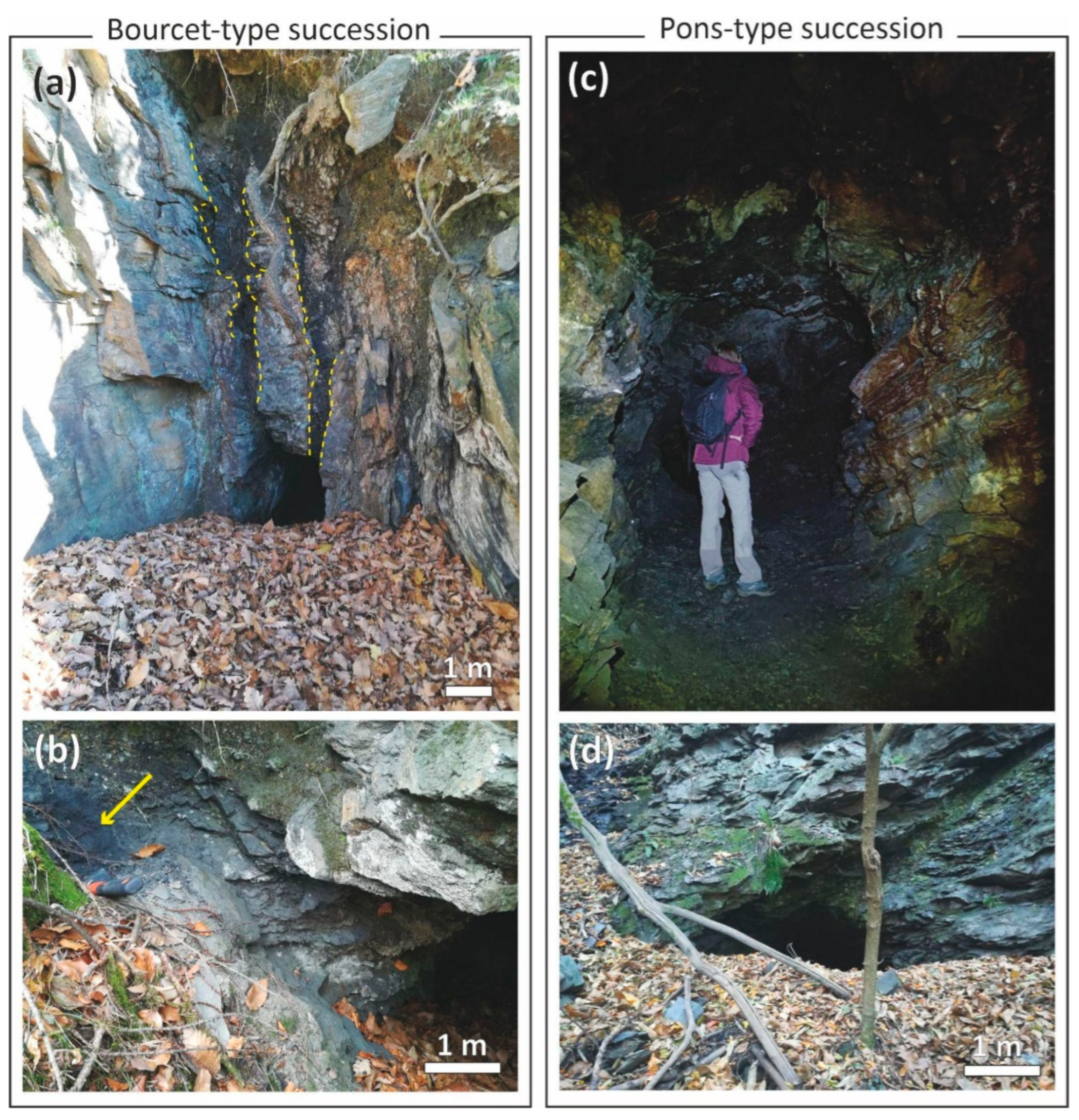
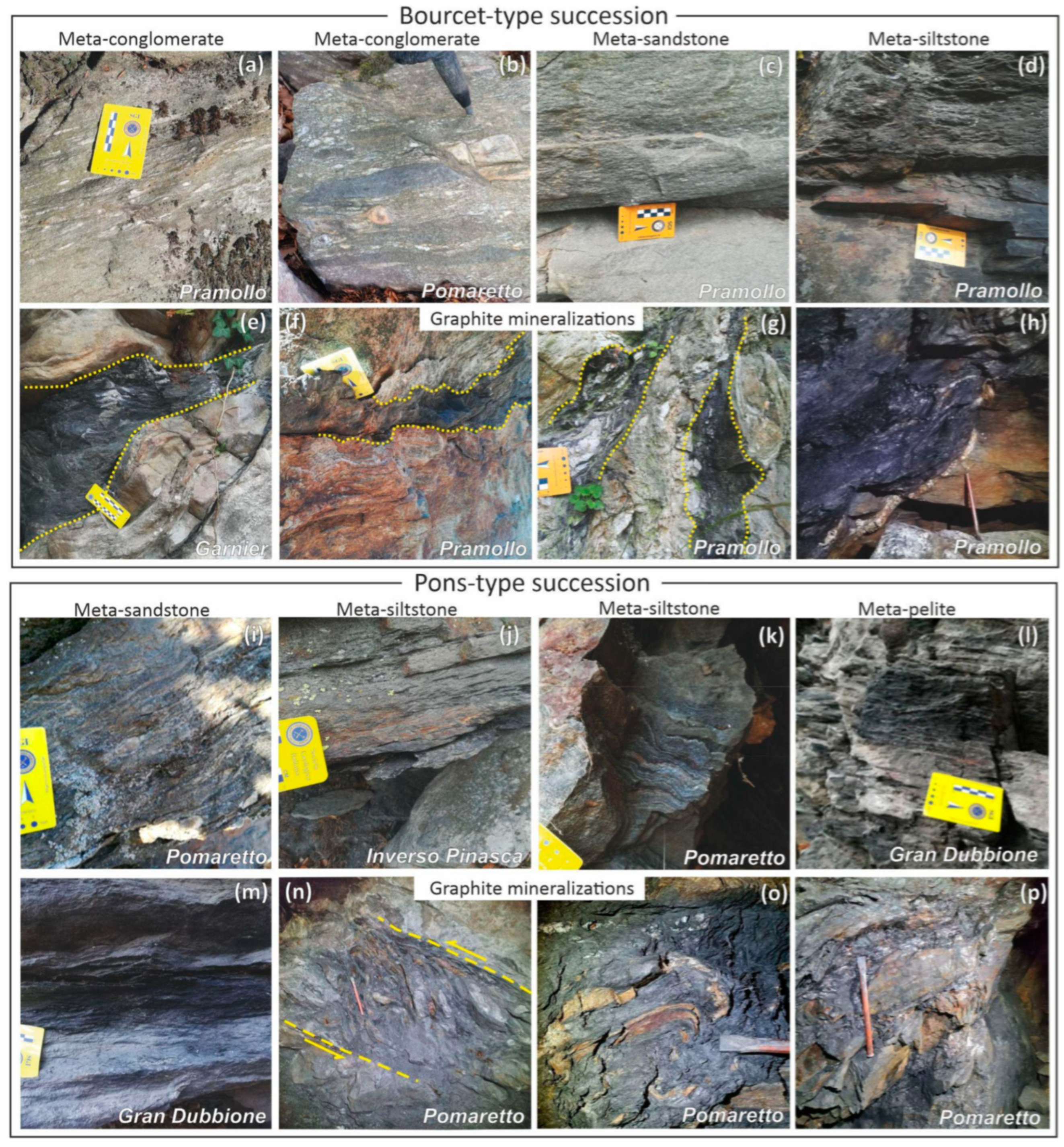

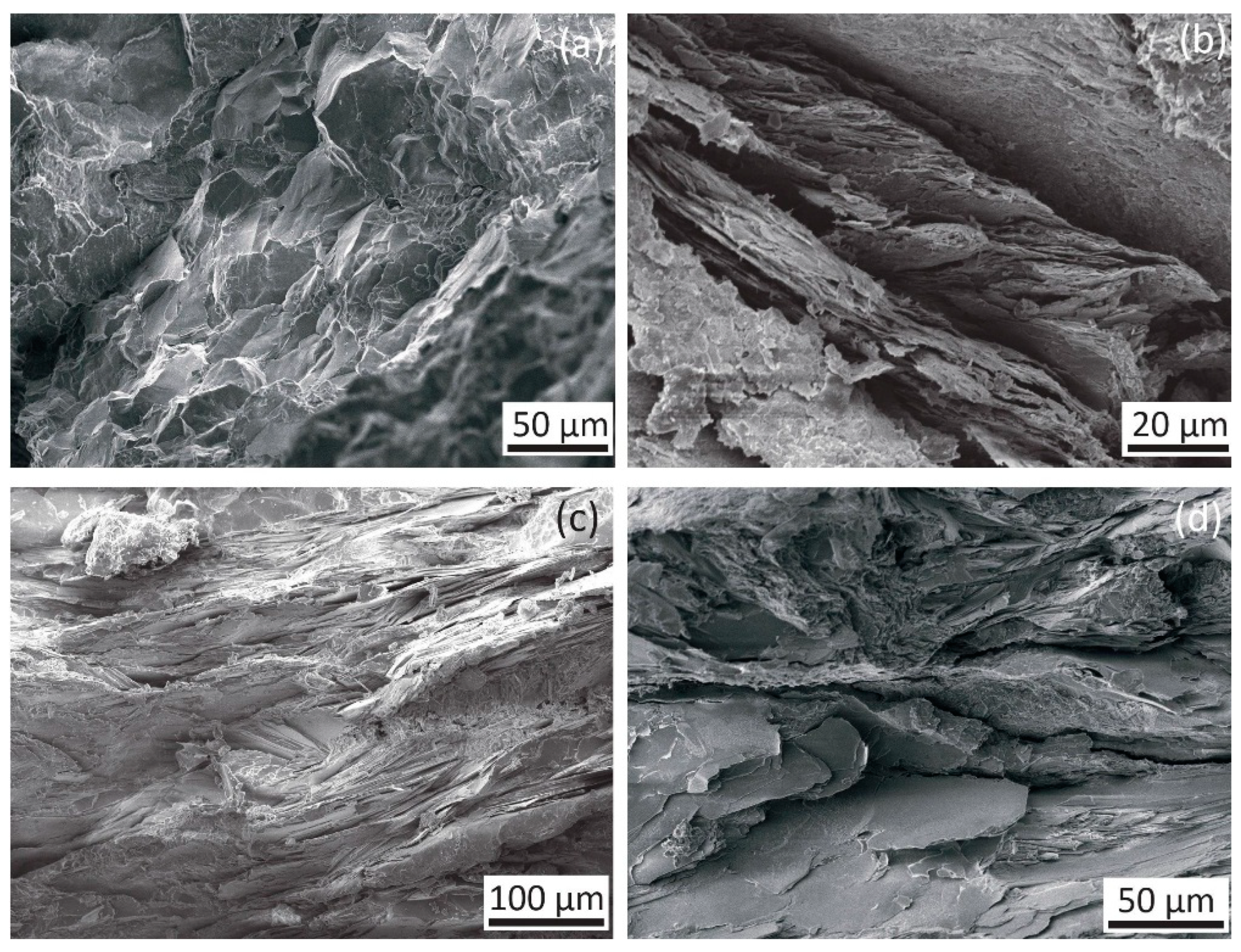
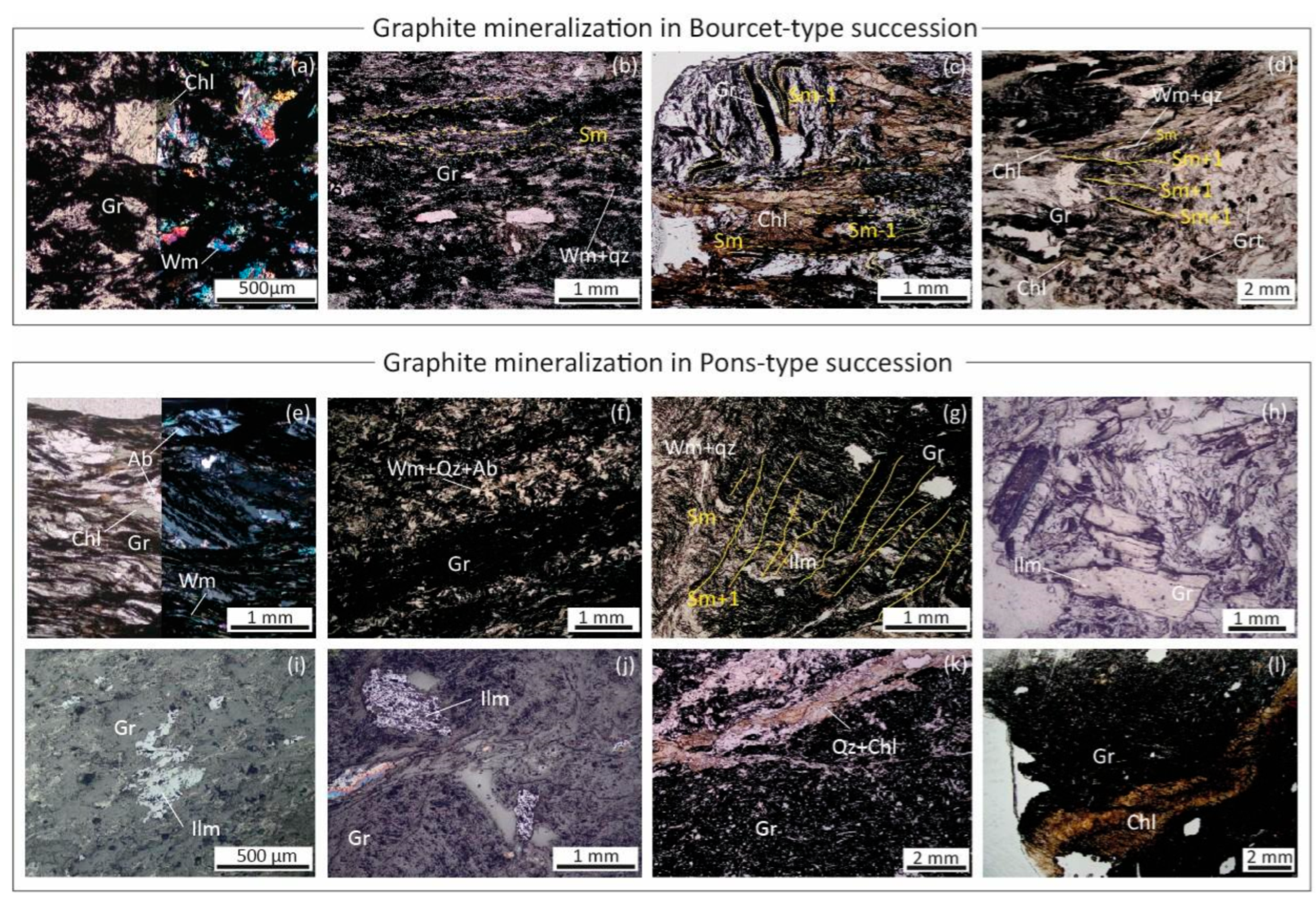
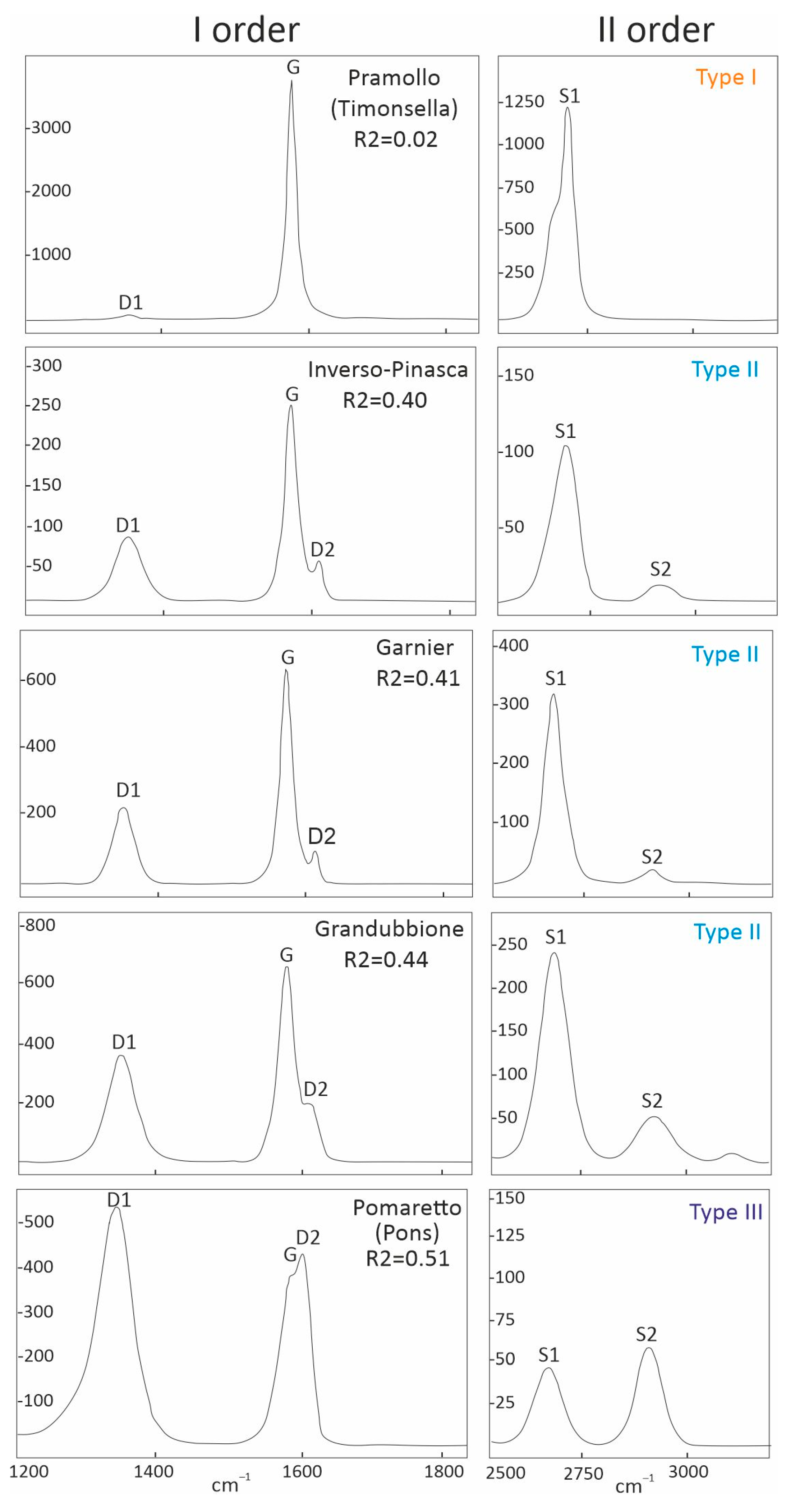

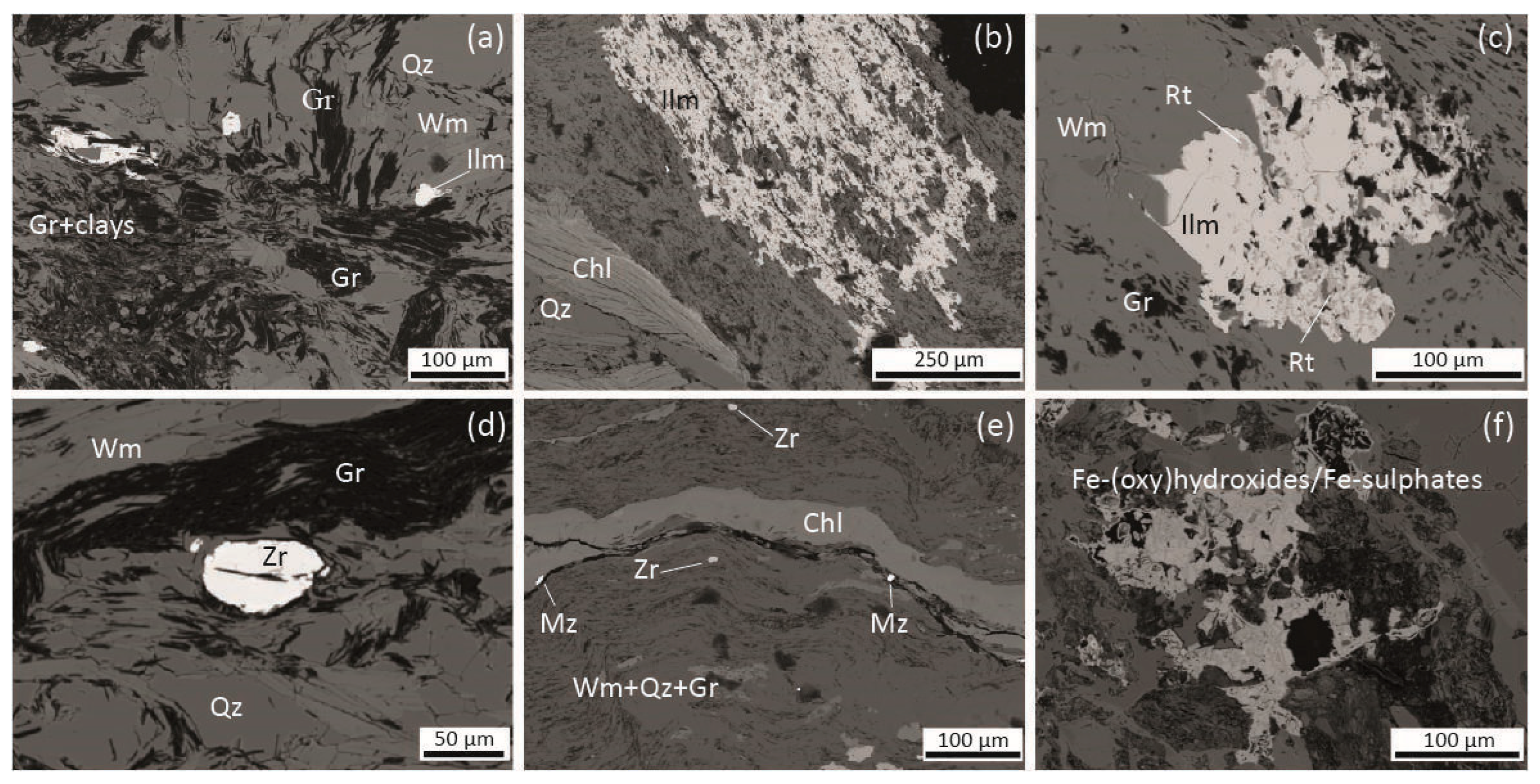

| Provenance Area | Analysis ID | D1 Position | D1 Intensity | FWHM D1 | Area D1 | G Position | G Intensity | FWHM G | G Area | D2 Position | FWHM D2 | D2 Area | R1 | R2 |
|---|---|---|---|---|---|---|---|---|---|---|---|---|---|---|
| Garnier | GN06 | 1351.89 | 734.10 | 41.12 | 39,652.50 | 1580.84 | 1205.61 | 21.41 | 35,124.10 | 1621.50 | 12.78 | 2935.70 | 0.61 | 0.51 |
| Garnier | GN07 | 1352.60 | 226.17 | 34.81 | 8,818.23 | 1581.66 | 556.42 | 17.07 | 11,907.60 | 1622.96 | 11.54 | 1039.08 | 0.41 | 0.41 |
| Pomaretto (Pons) | PS01a (DM1887) | 1348.21 | 467.07 | 51.19 | 27,510.60 | 1592.03 | 347.09 | 33.91 | 14,441.70 | 1614.61 | 22.93 | 11,621.30 | 1.35 | 0.51 |
| Pomaretto (Pons) | PS01b (DM1887) | 1350.37 | 656.08 | 42.90 | 32,113.70 | 1587.83 | 611.14 | 33.45 | 24,491.60 | 1616.17 | 23.47 | 7823.48 | 1.07 | 0.50 |
| Pomaretto (Clot di Boulard) | PS12 | 1352.64 | 433.14 | 41.76 | 21,008.20 | 1582.70 | 851.66 | 19.71 | 22,522.40 | 1622.77 | 12.61 | 2211.91 | 0.51 | 0.46 |
| Grandubbione | GR01 | 1352.48 | 351.97 | 46.12 | 18,883.70 | 1584.38 | 647.15 | 26.07 | 19,307.40 | 1619.16 | 26.22 | 4972.21 | 0.54 | 0.44 |
| Inverso-Pinasca | IP05 | 1354.22 | 79.93 | 44.90 | 3994.37 | 1582.40 | 214.80 | 20.28 | 5390.77 | 1622.71 | 12.97 | 560.35 | 0.37 | 0.40 |
| Inverso-Pinasca | IP01 | 1352.05 | 480.34 | 43.76 | 25,890.30 | 1582.62 | 832.82 | 22.94 | 23,443.20 | 1621.36 | 15.16 | 3304.74 | 0.58 | 0.49 |
| Inverso-Pinasca | DM1886 | 1356.37 | 253.52 | 43.56 | 13,586.10 | 1583.60 | 520.94 | 20.72 | 14,470.60 | 1623.14 | 12.84 | 3476.96 | 0.49 | 0.43 |
| Pramollo (West Siassiera) | PR02 | 1351.94 | 319.55 | 44.75 | 20,728.40 | 1581.59 | 2867.85 | 17.75 | 63,147.70 | 1622.86 | 17.73 | 5025.54 | 0.11 | 0.23 |
| Pramollo (Timonsella) | DM1867a | 1349.95 | 140.77 | 32.65 | 1405.76 | 1581.64 | 1258.05 | 15.60 | 68,148.20 | 1610.77 | 28.84 | 5141.40 | 0.11 | 0.02 |
| Pramollo (Timonsella) | DM1867b | 1354.16 | 54.41 | 42.23 | 6495.24 | 1581.46 | 3488.75 | 17.08 | 29,868.40 | 1621.82 | 11.10 | 966.78 | 0.02 | 0.17 |
| Pramollo (Icla Brutta Comba) | PR01 | 1351.01 | 199.39 | 43.80 | 10,895.70 | 1582.07 | 433.67 | 23.36 | 13,122.60 | 1616.78 | 28.80 | 2100.45 | 0.46 | 0.42 |
| C | Mg | Al | Si | K | Fe | Ba | Ti | Ca | Mn | Na | S | F | |
|---|---|---|---|---|---|---|---|---|---|---|---|---|---|
| Wt. % | |||||||||||||
| Pramollo (West Siassiera) | 98.59 | 1.41 | |||||||||||
| 99.51 | 0.14 | 0.17 | |||||||||||
| 99.29 | 0.21 | 0.26 | 0.10 | 0.14 | |||||||||
| Pramollo (Dormigliosi-Timonsella) | 98.32 | 0.60 | 0.90 | 0.17 | |||||||||
| 97.39 | 2.11 | ||||||||||||
| 99.56 | 0.12 | 0.21 | |||||||||||
| Inverso-Pinasca | 54.05 | 1.39 | 12.28 | 21.44 | 8.18 | 1.97 | 0.08 | 0.39 | 0.03 | 0.19 | |||
| 53.82 | 1.34 | 12.68 | 21.49 | 8.44 | 0.10 | 0.27 | 0.05 | 0.03 | 0.16 | ||||
| Garnier | 89.01 | 0.72 | 2.31 | 3.67 | 0.82 | 2.81 | 2.26 | ||||||
| 90.71 | 0.53 | 2.22 | 3.41 | 1.07 | 1.70 | 0.12 | |||||||
| 92.94 | 0.13 | 0.33 | 6.07 | 0.14 | 0.28 | 0.10 | |||||||
| 91.67 | 0.28 | 1.29 | 1.95 | 0.29 | 4.09 | 0.11 | |||||||
| Pomaretto (Pons) | 88.94 | 0.16 | 10.38 | 0.20 | 0.30 | ||||||||
| 86.63 | 2.65 | 6.89 | 1.43 | 0.89 | 0.23 | 0.67 | |||||||
| Al2O3 | MgO | CaO | SiO2 | SO2 | K2O | TiO2 | MnO | NiO | FeO | V2O3 | ZrO2 | |
|---|---|---|---|---|---|---|---|---|---|---|---|---|
| Ilmenite | ||||||||||||
| Wt. % | ||||||||||||
| Pramollo (Timonsella) | 0.14 | 0.21 | 52.16 | 4.49 | 42.57 | 0.44 | ||||||
| Grandubbione | 0.12 | 0.2 | 48.31 | 2.87 | 48.13 | 0.38 | ||||||
| Inverso-Pinasca | 0.1 | 0.21 | 47.99 | 2.94 | 48.34 | 0.42 | ||||||
| Pomaretto (Pons) | 0.17 | 0.16 | 47.16 | 1.59 | 50.44 | 0.48 | ||||||
| Rutile | ||||||||||||
| Wt. % | ||||||||||||
| Pramollo (Timonsella) | 0.42 | 98.43 | 0.19 | 0.97 | ||||||||
| Pramollo (Timonsella) | 0.31 | 97.83 | 0.65 | 1.21 | ||||||||
| Pomaretto (Pons) | 0.14 | 0.18 | 98.48 | 0.47 | 0.73 | |||||||
| Zircon | ||||||||||||
| Wt. % | ||||||||||||
| Pramollo (Timonsella) | 0.31 | 31.32 | 0.75 | 67.62 | ||||||||
| Grandubbione | 0.13 | 31.41 | 0.21 | 68.21 | ||||||||
| Pomaretto (Pons) | 0.73 | 32.59 | 0.41 | 66.07 | ||||||||
| Fe.(oxy)hydroxides | ||||||||||||
| Wt. % | ||||||||||||
| Pomaretto (Pons) | 0.23 | 1.56 | 0.32 | 0.22 | 68.44 | |||||||
| 0.94 | 1.34 | 0.72 | 0.26 | 68.59 | ||||||||
| O | F | P | K | Ca | Si | Fe | S | Ni | Ti | |||
| Pyrite | ||||||||||||
| Wt. % | ||||||||||||
| Grandubbione | 0.14 | 58.86 | 39.2 | 1.56 | ||||||||
| Pomaretto (Pons) | 0.24 | 55.83 | 43.36 | 0.33 | ||||||||
| Apatite | ||||||||||||
| Wt. % | ||||||||||||
| Pomaretto (Pons) | 37.41 | 4.62 | 19.92 | 0.23 | 41.83 | |||||||
| Monazite | Xenotime | ||
|---|---|---|---|
| Grandubbione | Pomaretto (Pons) | Grandubbione | |
| Wt. % | |||
| Al2O3 | 0.26 | 0.39 | 0.21 |
| MgO | 0.45 | ||
| CaO | 0.54 | ||
| SiO2 | 0.29 | 0.63 | 1.44 |
| MnO | 0.26 | 0.13 | 0.14 |
| FeO | 1.26 | ||
| ZrO2 | 0.28 | ||
| PO2 | 30.95 | 29.14 | 33.44 |
| CeO2 | 29.02 | 30.51 | |
| La2O3 | 14.33 | 14.86 | |
| Pr2O3 | 3.37 | 3.36 | |
| Sm2O3 | 3.37 | 2.24 | 1.35 |
| Gd2O3 | 2.77 | 1.41 | 6.23 |
| Dy2O3 | 0.82 | 0.51 | 9.22 |
| Y2O3 | 0.63 | 40.36 | |
| ThO2 | 1.83 | ||
| UO2 | 0.21 | ||
| Yb2O3 | 1.28 | ||
Disclaimer/Publisher’s Note: The statements, opinions and data contained in all publications are solely those of the individual author(s) and contributor(s) and not of MDPI and/or the editor(s). MDPI and/or the editor(s) disclaim responsibility for any injury to people or property resulting from any ideas, methods, instructions or products referred to in the content. |
© 2025 by the authors. Licensee MDPI, Basel, Switzerland. This article is an open access article distributed under the terms and conditions of the Creative Commons Attribution (CC BY) license (https://creativecommons.org/licenses/by/4.0/).
Share and Cite
Santoro, L.; Bertone, V.; Ferrando, S.; Groppo, C. New Insights into Graphite Deposits in Chisone and Germanasca Valleys (Dora-Maira Massif, Western Italian Alps): Scientific Advances and Applied Perspectives. Minerals 2025, 15, 455. https://doi.org/10.3390/min15050455
Santoro L, Bertone V, Ferrando S, Groppo C. New Insights into Graphite Deposits in Chisone and Germanasca Valleys (Dora-Maira Massif, Western Italian Alps): Scientific Advances and Applied Perspectives. Minerals. 2025; 15(5):455. https://doi.org/10.3390/min15050455
Chicago/Turabian StyleSantoro, Licia, Viviane Bertone, Simona Ferrando, and Chiara Groppo. 2025. "New Insights into Graphite Deposits in Chisone and Germanasca Valleys (Dora-Maira Massif, Western Italian Alps): Scientific Advances and Applied Perspectives" Minerals 15, no. 5: 455. https://doi.org/10.3390/min15050455
APA StyleSantoro, L., Bertone, V., Ferrando, S., & Groppo, C. (2025). New Insights into Graphite Deposits in Chisone and Germanasca Valleys (Dora-Maira Massif, Western Italian Alps): Scientific Advances and Applied Perspectives. Minerals, 15(5), 455. https://doi.org/10.3390/min15050455







